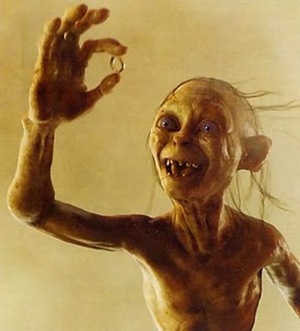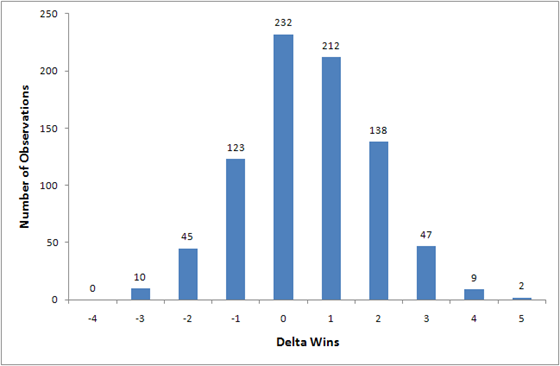cullen christian
[Ed: bump!]
Back in April, I wrote a diary called Blue Moon in my Eye in which I developed a regression model that could be used to develop a projected win total assuming that reasonable estimates had been used as inputs. At the time I thought that the team would be capable of winning at least seven, probably eight, and maybe even nine out of thirteen games this season. Since then, things have, uh, how do you say … changed. With the loss of Woolfolk, how do those numbers change?
The New Blue Moon
 Before I get to that, there’s a good reason to update the model. In April, I mentioned that turnover margin is meaningful factor in regard to outcomes, but I lacked enough data to break it out specifically and therefore decided to leave it as a lumped parameter; turnovers were doomed to fade into the ether that is Intercept. No more, the NCAA has finally included turnover data in its database and now there is enough data to mix into the model. The new model has an improved R-squared value (0.752 as improved from 0.675) using just three end-of-year factors: offensive yards per game, defensive yards per game, and total turnover margin. Last time I didn’t include the model because it was mine, my own, my … preciousss. That was incredibly lame and nerdy (both with holding the coefficients and referencing LOTR) but we’re talking stats here so no one should be surprised. Another reason for divulging the goods is, now that there are four dimensions, a chart would be useless. Behold, the Blue Moon Model coefficients:
Before I get to that, there’s a good reason to update the model. In April, I mentioned that turnover margin is meaningful factor in regard to outcomes, but I lacked enough data to break it out specifically and therefore decided to leave it as a lumped parameter; turnovers were doomed to fade into the ether that is Intercept. No more, the NCAA has finally included turnover data in its database and now there is enough data to mix into the model. The new model has an improved R-squared value (0.752 as improved from 0.675) using just three end-of-year factors: offensive yards per game, defensive yards per game, and total turnover margin. Last time I didn’t include the model because it was mine, my own, my … preciousss. That was incredibly lame and nerdy (both with holding the coefficients and referencing LOTR) but we’re talking stats here so no one should be surprised. Another reason for divulging the goods is, now that there are four dimensions, a chart would be useless. Behold, the Blue Moon Model coefficients:
|
Coefficients |
Norm. Coefficients |
P-value |
|
| Intercept | 0.579253998 | 0.515607437 | 3.79693E-55 |
| OffYds/G | 0.001753298 | 0.107573121 | 7.5351E-118 |
| DefYds/G | -0.001981349 | -0.112371575 | 2.1098E-122 |
| TrnOvrMgn_Total | 0.007973783 | 0.065213954 | 5.75637E-50 |
- I left the P-Values in there for those who know what that is. For the rest of you, it suffices to say what I said last time: that ish be money, yo.
- The second column (Normalized Coefficients) is there to demonstrate the relative importance of each factor; in short, defense is a skosh more influential than offense and turnover margin is a little over half as important as both.
- The use of the model (first column) is simple, start with the intercept then multiply the other the coefficients with their interrogation values and add everything together. Use it to gamble at your own peril. Until such a time as you can accurately predict end of year stats for these categories, the model is only good for using as a platform to base sophisticated guesses off of.
-
Probable influential factors that are embedded in the 25% of the variation not explained by the model (1 – R_squared) are:
- Return Teams effectiveness. Good return teams will establish good field position thus reducing OffYds/G.
- Coverage Teams effectiveness. Bad units will allow the other team to establish good field position thereby reducing DefYds/G.
- Field Goal Kicking effectiveness. If you get into field goal position and miss, you’ll have a lot of yards but nothing to show for them.
- Penalties. Penalty yardage will increase/decrease your production depending on if they’re called on you or them but doesn’t necessarily change how effective each team is at controlling field position.
- In round terms, factor influence on winning percentage breaks down to 30% Offense, 30% Defense, 15% Turnover Margin, and 25% Other Things.
Shine Down on the Big Ten (and it’s self-absorbed neighbor)
Below is 2009 Big Ten Data and Blue Moon Model expectation (BMM Expect).
| Team | OffYds/G | DefYds/G | TrnOvrMgn_Tot | 2009 Wins | BMM Expect. | Delta Wins |
| Ohio St. | 364.8 | 262.5 | 17 | 11 | 11 | 0 |
| Penn St. | 412.5 | 277.1 | 6 | 11 | 10 | 1 |
| Iowa | 330.8 | 286.7 | 2 | 11 | 8 | 3 |
| Wisconsin | 415.8 | 310.4 | 3 | 10 | 9 | 1 |
| Northwestern | 386 | 344.3 | 4 | 8 | 8 | 0 |
| Michigan St. | 407.1 | 364.3 | -6 | 6 | 7 | -1 |
| Minnesota | 295.8 | 364.3 | -1 | 6 | 5 | 1 |
| Notre Dame | 451.8 | 397.8 | 5 | 6 | 7 | -1 |
| Purdue | 391.3 | 376.6 | -5 | 5 | 6 | -1 |
| Michigan | 384.5 | 393.3 | -12 | 5 | 5 | 0 |
| Indiana | 365 | 401 | 7 | 4 | 6 | -2 |
| Illinois | 393.5 | 403.3 | -4 | 3 | 5 | -2 |
With cornerback as a big concern, and only a few weeks left in this class, the Wolverines start to look to the juniors for help. Lo Wood was just offered by Michigan, and we will hear from him soon. Another name that we will start to hear from is Penn Hills Cullen Christian. He's 6'1 180 pounds, and already has an offer from U of M. Christian is teammates with LB Dan Mason from this years class, and junior WR Brandon Ifill, who is also a Michigan prospect. Here's one of his highlight videos, and what he had to say about his recruitment.
TOM: You were just at the Junior Combine, how did that go?
CULLEN: It was good, a good experience. I did pretty good. The goal was just to do the best I could do in the 1 on 1’s, since it’s the wide receivers advantage. My name was on the list for good performers, so I feel like I did well.
TOM: Did you meet any other recruits that you’ll keep in touch with?
CULLEN: I met so many people, too many to name. It was good to meet a lot of the other recruits.
TOM: You’re teammates with Brandon Ifill and Dan Mason, has Dan’s recruitment helped you guys at all?
CULLEN: Yea he definitely showed us a couple things. There’s a lot of coaches that talk to Dan, and he has put in good words for us.
TOM: What schools do you think Dan Mason likes right now?
CULLEN: Top schools are WVU, Penn State, BC, and Pitt.
TOM: Will you and Brandon be a package deal, or are you looking at different schools?
CULLEN: We’re not going out of our way to go to same, but if something happens it happens. Most of the schools are looking at both of us.
TOM: Do you have any favorites to start, I know they usually change, but who sticks out right now?
CULLEN: Michigan, Pitt, Maryland. I was just offered by Maryland, so those are all my offers too.
TOM: Is there somewhere you’ve always wanted to visit? Or any schools you know you’ll definitely visit for a game?
CULLEN: There’s not really a school I’ve always wanted to visit; growing up I always liked Michigan. I was supposed to go on the 15th, but there’s a track meet so I’m going to reschedule. I really like them.
TOM: What camps do you plan on going to, or have you been to?
CULLEN: Scouts camp, Penn State, Adidas. I’m not sure about team camps yet.
TOM: How do you see your recruitment going? A lot of guys commit real quick, and some take their time, what will you do?
CULLEN: I’m going to take my time; I’m going to take all 5 visits. I don’t want to go through any decommits or anything, when I commit there will be no second guessing.
TOM: What are you looking for in a school? Do you look at early playing time, coaches, tradition?
CULLEN: I want early playing time, a school that has good tradition, the academics. That’s basically what I want to go to college for. The most important are playing time and academics. I don’t want to have to wait all the way to senior year.
TOM: Describe what kind of player you are, and what you bring to a college team.
CULLEN: I’m a real physical corner, I can watch bigger receivers, I won’t get out jumped, and I won’t get out ran. I can run with the quick ones and tackle the big ones. Especially if I went to Michigan, you need to know how to tackle in the Big Ten.

77